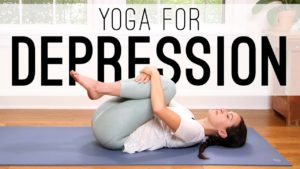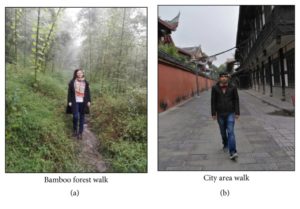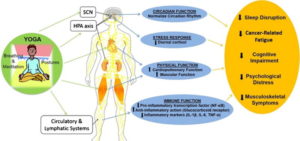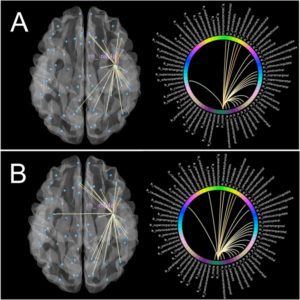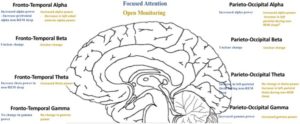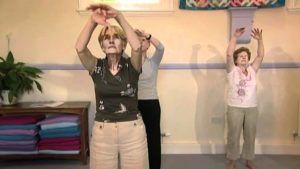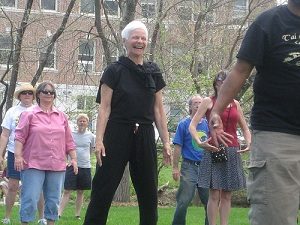Improve Cognition in Patients with Major Depression with Yoga
By John M. de Castro, Ph.D.
“for many patients dealing with depression, anxiety, or stress, yoga may be a very appealing way to better manage symptoms. Indeed, the scientific study of yoga demonstrates that mental and physical health are not just closely allied, but are essentially equivalent. The evidence is growing that yoga practice is a relatively low-risk, high-yield approach to improving overall health.” – Harvard Health
Clinically diagnosed depression is the most common mental illness, affecting over 6% of the population. Major depression can be quite debilitating. It is also generally episodic, coming and going. Some people only have a single episode but most have multiple reoccurrences of depression. Depression can be difficult to treat. It is usually treated with antidepressant medication. But, of patients treated initially with drugs only about a third attained remission of the depression. After repeated and varied treatments including drugs, therapy, exercise etc. only about two thirds of patients attained remission. But, drugs often have troubling side effects and can lose effectiveness over time. In addition, many patients who achieve remission have relapses and recurrences of the depression. Even after remission some symptoms of depression may still be present (residual symptoms), including impairments in thinking (cognition).
Being depressed and not responding to treatment or relapsing is a terribly difficult situation. The patients are suffering and nothing appears to work to relieve their intense depression. Suicide becomes a real possibility. So, it is imperative that other treatments be identified that can relieve the suffering. Mindfulness training is an alternative treatment for depression. It has been shown to be an effective treatment for depression and its recurrence and even in the cases where drugs fail. Another effective alternative treatment is exercise. But it is difficult to get depressed people, who lack energy, to engage in regular exercise. Yoga is a contemplative practice that is both a mindfulness practice and an exercise. It has been shown to be effective in the treatment of depression.
A frequent residual symptom of depression is a decrease in cognitive ability. In today’s Research News article “Improvement in neurocognitive functions and serum brain-derived neurotrophic factor levels in patients with depression treated with antidepressants and yoga.” (See summary below or view the full text of the study at: https://www.ncbi.nlm.nih.gov/pmc/articles/PMC5914260/ ), Halappa and colleagues examine the ability of yoga practice with and without concurrent treatment with antidepressant drugs to relieve depression and impairment of cognition.
They recruited patients with major depressive disorder who were not being treated with antidepressant drugs. They were randomly assigned to receive either antidepressant drugs alone, yoga therapy alone, or yoga therapy in combination with antidepressant drugs. Yoga practice occurred for 1 hour, twice a week for 12 weeks. Age and education matched healthy individuals were also recruited as control participants. They were assessed before and after treatment for depression and cognitive ability with Rey auditory verbal learning test, digit span test, and Trail Making Test. They also had blood drawn for assay of serum brain-derived neurotrophic factor (BDNF) levels
They found, not surprisingly, that at baseline the patients were significantly more depressed and had significantly poorer cognitive performance and BDNF levels than the healthy controls and that the three experimental groups did not significantly differ. After treatment all three groups showed improvement in cognitive ability and increases in BDNF levels, but the yoga alone and the yoga with antidepressant drugs groups performed significantly better than antidepressant drugs alone group. Importantly, the treated groups cognitive performance levels after treatment were comparable to the levels achieved by the healthy control participants.
These results are interesting and potentially important. They suggest that yoga practice alone or in combination with antidepressant drugs produces better improvements in cognition and brain chemistry than the drugs by themselves. Since yoga plus drugs did not produce greater improvements than yoga alone, and yoga alone produced superior benefits than the drugs alone, it would appear that the drugs are not needed and yoga practice by itself is sufficient to improve cognitive performance in patients with major depressive disorder.
This is remarkable and very important. Yoga practice alone can seemingly reverse the deficits in thinking that accompany major depression bring them to normal levels. Yoga practice also does not have the troubling side effects of antidepressant drugs. This study suggests that it a safe and effective treatment. It is also very inexpensive as it can be practiced at home. In addition, yoga has been shown to be effective in the treatment of depression.
So, improve cognition in patients with major depression with yoga.
“These studies suggest that yoga-based interventions have promise as an intervention for depressed mood and that they are feasible for patients with chronic, treatment-resistant depression,” -Nina Vollbehr
CMCS – Center for Mindfulness and Contemplative Studies
This and other Contemplative Studies posts are also available on Google+ https://plus.google.com/106784388191201299496/posts and on Twitter @MindfulResearch
Study Summary
Halappa, N. G., Thirthalli, J., Varambally, S., Rao, M., Christopher, R., & Nanjundaiah, G. B. (2018). Improvement in neurocognitive functions and serum brain-derived neurotrophic factor levels in patients with depression treated with antidepressants and yoga. Indian Journal of Psychiatry, 60(1), 32–37. http://doi.org/10.4103/psychiatry.IndianJPsychiatry_154_17
Abstract
Context and Aims:
Impairment in cognition is well-known in patients with major depressive disorder. This study examined the effect of yoga therapy with or without antidepressants and antidepressants alone on certain neuropsychological functions in patients with depression. Correlation between changes in neuropsychological test performance and serum brain-derived neurotrophic factor (BDNF) levels was also explored.
Materials and Methods:
Antidepressant-naïve/antidepressant-free outpatients with depression received antidepressant medication alone (n = 23) or yoga therapy with (n = 26) or without (n = 16) antidepressants. Depression was assessed using the Hamilton Depression Rating Scale. Neuropsychological tests included digit-span forward and backward, Rey Auditory Verbal Learning Test, and Trail Making Tests (TMT-A and B). These tests were administered before and 3 months after the treatment in patients, and once in healthy comparison subjects (n = 19).
Statistical Analysis:
Baseline differences were analyzed using independent sample t-test, Chi-square, and one-way ANOVA. Paired t-test was used to analyze the change from baseline to follow-up. Pearson’s correlation was used to explore the association of change between 2 variables.
Results:
Patients had impaired performance on most neuropsychological tests. After 3 months, there was significant improvement – patients’ performance was comparable to that of healthy controls on majority of the tests. Significant inverse correlation was observed between increase in BDNF levels and improvement in TMT “A” duration in Yoga-alone group (r = −0.647; P = 0.009).
Conclusions:
To conclude that, Yoga therapy, alone or in combination with medications, is associated with improved neuropsychological functions and neuroplastic effects in patients with depression.
https://www.ncbi.nlm.nih.gov/pmc/articles/PMC5914260/
